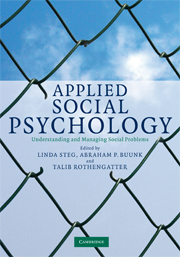Book contents
- Frontmatter
- Contents
- List of figures
- List of tables
- List of boxes
- List of contributors
- Acknowledgments
- 1 Introduction to applied social psychology
- 2 The USE of theory in applied social psychology
- 3 Applications of social psychology to increase the impact of behaviour-focused intervention
- 4 Research designs in applied social psychology
- 5 Social psychology and economic behaviour: heuristics and biases in decision making and judgement
- 6 Social psychology and immigration: relations between immigrants and host societies
- 7 Applying social psychology to the classroom
- 8 Social psychology and environmental problems
- 9 Gender issues in work and organizations
- 10 Social psychology of health and illness
- 11 Social psychology and mental health
- 12 Social psychology and modern organizations: balancing between innovativeness and comfort
- 13 Social psychology and the study of politics
- Index
- References
6 - Social psychology and immigration: relations between immigrants and host societies
- Frontmatter
- Contents
- List of figures
- List of tables
- List of boxes
- List of contributors
- Acknowledgments
- 1 Introduction to applied social psychology
- 2 The USE of theory in applied social psychology
- 3 Applications of social psychology to increase the impact of behaviour-focused intervention
- 4 Research designs in applied social psychology
- 5 Social psychology and economic behaviour: heuristics and biases in decision making and judgement
- 6 Social psychology and immigration: relations between immigrants and host societies
- 7 Applying social psychology to the classroom
- 8 Social psychology and environmental problems
- 9 Gender issues in work and organizations
- 10 Social psychology of health and illness
- 11 Social psychology and mental health
- 12 Social psychology and modern organizations: balancing between innovativeness and comfort
- 13 Social psychology and the study of politics
- Index
- References
Summary
Introduction
Globalization, migration and increasing cultural diversity within nations have resulted in a growing need to understand and enhance intercultural relations in plural societies. The purpose of this chapter on relations between immigrants and host societies is to highlight current trends and new advances in the study of acculturation and intergroup relations. To accomplish this, the chapter provides an overview of migration and cultural diversity across four major geographical regions; describes the evolution of acculturation theory, models and research; briefly reviews the developments in the application of social-psychological theory to the study of immigration and intergroup relations; discusses the convergence of these two approaches; offers suggestions how applied social psychology may help to solve intercultural problems; and makes recommendations for the course of future research.
Migration and cultural diversity in the twenty-first century
It is now estimated that there are almost 191 million international migrants on a world-wide basis. Europe currently hosts the largest number (64 million), which is about 8% of its population. However, relative to the total population, Oceania (15%) and North America (13%) are world leaders. Brief synopses of their immigration trends and issues are presented in the following sections.
- Type
- Chapter
- Information
- Applied Social PsychologyUnderstanding and Managing Social Problems, pp. 141 - 161Publisher: Cambridge University PressPrint publication year: 2008



